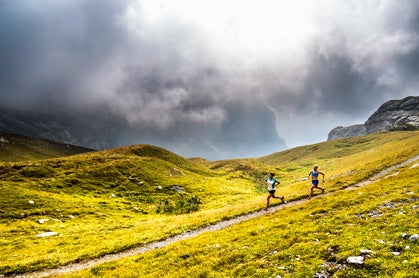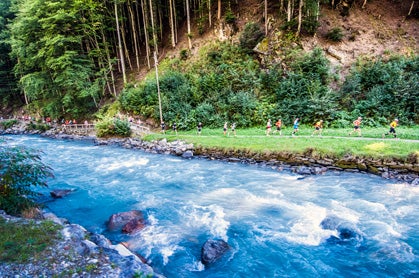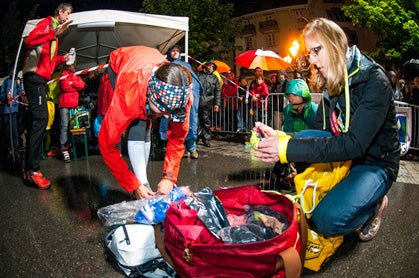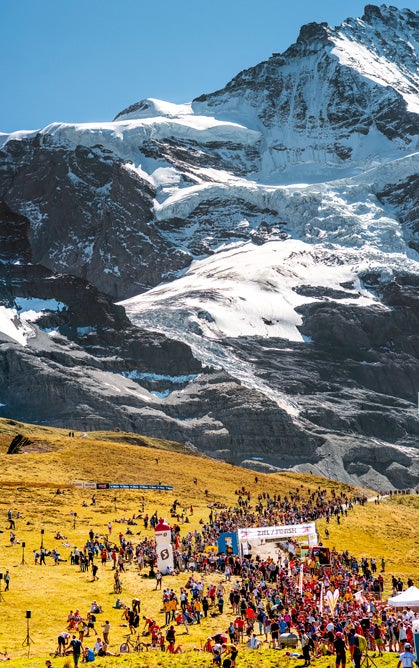New perk! Get after it with local recommendations just for you. Discover nearby events, routes out your door, and hidden gems when you sign up for the Local Running Drop.
French Ta · per (noun): To pull an all-nighter crewing the Ultra-Trail du Mont-Blanc before running the World Long Distance Mountain Running Challenge

Gina Lucrezi (left) and the author scope the final miles of the Jungfrau Marathon course before race day. Photo by Chris Hunter.
When I lined up at the 20th Anniversary Jungfrau Marathon in Interlaken, Switzerland, I felt the non-linear construct of time: I was simultaneously back in my kitchen in Carbondale, Colorado, on a cool spring afternoon watching the Jungfrau course video with my roommate, Gina Lucrezi, and also on the start line, jumping up and down, shaking out my legs, expelling nervous energy amid hundreds of runners.
As always before race starts, we took countless runs to the Porta Potties, to the nearby grass and, when there was no time at all, a few racers took a final pee on the start line. I felt as expected: An avocado-pit of nervousness churned in my gut and I felt as though I could puke, cry or both. And, yet, I was smiling. After days of dreary rain and fog, the sky had cleared to crystal blue and the jagged Jungfrau, the third-highest peak in the Bernese Alps, jutted into the sky.
The Jungfrau Marathon is one of the most scenic marathons in the world. It starts in the center of Interlaken directly in front of the incongruous American Hooter’s restaurant. The course first makes a loop through downtown’s mixture of ethnic restaurants, shaded streets and touristy boutiques and along the aquamarine Aare River that divides the town.
The route then passes tidy neighborhoods of gingerbread houses overflowing with window flower boxes and perfectly manicured front stoops—perhaps it’s the cleanest marathon course, too. Then it goes along relatively flat paved paths, roads and crushed gravel trails for close to 10 miles before tilting sharply upward to finish on the Kleine Sheidegg—the mountain pass that sits below the towering peaks of the Eiger, Mönch and Jungfrau—at 6762 feet.
This September, for the second year in a row, the race served as the World Long Distance (LD) Mountain Running Challenge—meaning that teams from countries around the world would be competing for both team and individual titles.
Unlike the World Mountain Running Championships, which take place on a “short course” (typically between five and eight miles), the LD Mountain Running Challenge is usually a marathon (42K) but must not exceed 45 kilometers, must have more than 1600 meters of elevation gain and the men’s course must take between 1 hour 45 minutes and 4 hours to complete.
The first-ever LD Mountain Running Challenge was held here at Jungfrau in 2004. I felt fortunate to be lining up in Switzerland where it had all started, as part of Team USA with four other women: Kim Dobson, Brandy Erholtz, Melody Fairchild and Gina.
Melody and Brandy were members of the 2012 U.S. Women’s Mountain Running Team, which won Gold the weekend before in Italy on the short uphill course. Lean and powerful, Melody sports long, chestnut-blonde braids and a warm face with the first hint of smile lines. She speaks articulately and evenly, displaying a quiet, collected energy. The 39-year-old from Boulder, Colorado, was the first high-school girl in U.S. history to run a sub-10-minute two-mile. She has qualified for the Olympic Trials in both the 10,000 meters (1996) and the marathon (2000) and was a member of the 1997 U.S. World Track and Field Championships team for the 5000 meters, claiming a 15:30 PR in that event.
Twice named Female Mountain Runner of the Year by USA Track and Field (2008 and 2009), Brandy, 35, has been a member of the U.S. Mountain Running team for five consecutive years. She transitioned to the mountain-running scene after winning the Northeast’s iconic Mount Washington Road Race in 2008 and 2009. The Evergreen, Colorado, resident talks like she runs uphill—fast. At the start, her short dark blonde hair was pulled back in braids, and muscular calves and quads revealed her proclivity for uphill terrain.
Kim, a rail-thin, standout uphiller who lives in Grand Junction, Colorado, had, this year alone, clenched an impressive win at Mount Washington, where she posted the second-fastest women’s time ever. Then, with $8000 on the line, she obliterated Colorado’s Pikes Peak Ascent women’s record by 8 minutes 32 seconds—a record set in 1981.
Having trained together at least once a week for much of the summer, I knew Kim was in the kind of shape it took to win the race, but you’d never know it by talking to her.
“After running such a strong race at Pikes, I didn’t feel any pressure for Jungfrau,” said Kim. “I just wanted to run a smart race and enjoy being part of a team.”
Gina, who is practically my sister and also the advertising manager at Trail Runner, was focussed, staring at the ground. She wore giant pearl earrings (I’ve never seen her without them), and her dark hair was pulled back in a tight, bobbing ponytail.
Earlier this summer, Gina had finished third in the La Sportiva Mountain Cup. She holds a mean 5K PR (16:40), and was a standout miler in college, posting a 4:32 1500-meter best and winning an NCAA Division III Championship in 2004. This was her first year focusing on longer distances, and the Jungfrau was her first marathon.
Stevie Kremer, 28, of Crested Butte, Colorado, was also on the line after making a last-minute decision to race—though not as part of this U.S. team—since she was living in Europe for the summer teaching.
“I don’t know what I’m doing here,” she murmured shaking her head while prancing around on her tiny, muscular frame. Like Gina, she has dark-brown hair and wears giant pearl earrings that look almost too heavy for her ears. Stevie displayed a nervous pessimism that could just as easily be read as sandbagging. “I am not fast on the road. I don’t belong here,” she continued.
Stevie said the same thing moments before crushing the Loon Mountain Race, the U.S. Mountain Championships earlier this summer where she slid her way to a fourth-place finish, earning the final spot on the team.
As for myself, I didn’t know what to expect. I had spent the last week in France indulging in too much of everything, including running more uphill terrain than I had any week this summer. I’d had a mid-season slump that meant I’d spent the last month feeling sluggish, burned out and depressed. I was confident in my climbing, although it was the 15 miles of road that scared me.
And, then, we were racing. The field took off aggressively. Spectators lined the streets, screaming encouragement in French, Italian, German and Spanish. Rows of flags and banners lined the course.
“The excitement was contagious,” Gina said later. “The fans were enthusiastic and compassionate about the race and the runners.”
Stevie took off in the lead pack with Kim trailing a few steps back in the chase. Melody, Gina, Brandy and I settled farther back into a comfortable 6:30ish-per-mile pace, chatting and laughing occasionally as we clicked off the road miles.
We hit a narrow gravel path and jockeyed with spandex-clad runners. I spent a frustrating 15 minutes bouncing back and forth with a tall, sweat-soaked man who smelled of a locker room and who was trying too hard to prevent me from passing. He eventually fell back, and that was that.
The four of us pushed the pace then backed off a little as we maneuvered short climbs and bridges, through tunnels of cowbell-ringing, flag-waving and shaker-shaking spectators.
“It was like I was out on a beautiful Sunday long run with friends,” Brandy said later.
The race became a dance, all of us sinking into rhythms just hard enough that we felt slight discomfort, a comfortable discomfort. I shook out my arms and my neck, anticipating the climb ahead and let my mind drift from the race until I was somewhere else entirely.

The course runs alongside the Weisse Lutschine River as it heads into Lauterbrunnen. Photo by Chris Hunter.
I took myself back to a little less than a week earlier, sitting in the front seat of an airport van headed from Geneva, Switzerland, to Chamonix, France, taking liberties with the driver’s iPod until I found something familiar—the Arctic Monkeys. I cranked up the volume so we could hear the music over the rolled-down windows that let in cool, humid air. Gina was slumped down in the backseat, nearly asleep.
“How’d you end up in Chamonix? What do you do? Where are you from? How did you get roped into picking us up at the airport?” Rather than casual small-talk, I interrogated our driver.
The Berkshire, England, native was wearing baggy pants, an old sweat-stained T-shirt and a black beanie, haphazardly thrown on sideways over a growing-out, flopped-over Mohawk.
To his benefit, my ability to converse quickly waned and jet lag took over. I rested my head on my seat-belt shoulder strap and peered out the window. Lush farmland and thick foliage extended up the green, sloping fields. Valley walls rose nearly vertical. As we neared Chamonix (at just over 3000 feet), Mont Blanc came into view and my vision tunneled.
Mont Blanc, known as “the rooftop of Europe,” is the highest mountain in the Alps, rising to 15,782 feet. I was instantly mesmerized by the sharp, dagger-like granite spires—the Chamonix Aiguilles—that stood juxtaposed against the enormous Mont Blanc glacier that spilled in apron folds down the mountain. Pillow clouds congregated near the summit, adding to the mystique.
I was here to crew Rory Bosio, 28, of Truckee, California, during her first-ever international ultra—the Ultra-Trail du Mont-Blanc (UTMB), arguably the most competitive and challenging footrace in Europe. The 166-kilometer course circumnavigates Mont Blanc and climbs a staggering 32,000 feet. To add to the race’s difficulty, it always starts in the evening, meaning everyone has to run technical mountain terrain in the dark.
Rory works nights as a nurse and seemed fine with pulling an all-nighter on the trails. “I’m used to staying up all night so it didn’t bother me,” she said. “It was weird, though, to lie around all day and then go race. … Too much time to kill … I was going stir crazy.”
This year alone, which served as the race’s 10th anniversary, “There were 50 people who could have finished in the top five based on their international racing experience and over 200 people who could have come in the top 20,” said race director Katherine Correra.
Problem was, since our arrival the weather had progressively deteriorated. What started as mist had turned to dense fog in the valley and deep snow and high winds on the mountain passes. Race morning, unsafe weather forced organizers to come up with a plan B for a third consecutive year. The premiere European event had been reduced to a 100K.
The race, which normally goes through Italy, France and Switzerland, would be run solely in France. For the leaders, that meant a race run entirely in the dark, through a cold, steady, miserable rain. Some runners seemed OK, taking the change in stride because of past years, while others complained they’d trained too long and hard for 166 kilometers to be forced to run a shorter distance. Others dropped out entirely.
“We all know we need to respect the weather conditions. Our ultimate goal, of course, is to get around the mountain and stay safe,” Jezz Brag of the UK, winner of the 2010 UTMB, said before the race. This was important to remember as I contemplated my job as crew in such inclement conditions. My task was to give Rory fresh gels and food at every crew-accessible checkpoint and, above all else, keep her spirits high.
At 6 p.m., I waded into the packed streets of Chamonix to cheer Rory off. Spectators crammed between late 18th- and early 19th-century buildings nestled aside cobbled walks and narrow lanes sandwiched between towering Mont Blanc and the opposing Aiguilles Rouges, a ridge of reddish, rocky peaks. The smell of baking cheese and eggs and buttery breads wafted out of ubiquitous pâtisseries.
Dozens of dark bars had their doors open wide; the stale smell of beer and cigarette smoke seeped onto the streets. The start was lined for a half mile with people holding their iPhones high, filming and snapping photos of the giant start arch.
Fog settled low in the valley, drifting into dark alleys as if the organizers had used a fog machine to evoke a sense of doom. Adding to the ambiance, the soundtrack of The Last of the Mohicans blasted around town. While some runners might have found this motivational, it made me laugh. “I feel like we’re here sending these people off to war,” I yelled over the crowd to Chris Hunter, a photographer friend of mine who was along to document the trip.
“This is insane!” Chris responded, from his perch on some nearby scaffolding. Chris wasn’t actually on the platform, though, as it was crammed with people. Instead, he hung by one arm over the crowd in the hopes of a clear view of the race start.
A three, two, one countdown … and the field took off. A giant wave of runners started with the front of the pack moving along at a sub 6:30-per-mile clip while the back of the packers were already walking.
I met up with my crewmates and we hurried off to the first checkpoint. It was dark and cold, and I was already tired when the frontrunners began to funnel through. A long espresso-filled, sleepless night awaited.

Rory Bosio changes her shoes and refuels in the rain with help from the author at UTMB’s first checkpoint. Photo by Chris Hunter.
Post UTMB I had scored several recoup days in Switzerland. And, thankfully, the weather improved—clear skies and an easy breeze gave way to a warming morning as we ran along the Jungfrau course.
“European races are so exciting because of the spectators,” Stevie said. While I’d expected the huge crowd at UTMB, I was surprised to see the same energy at Jungfrau. In the U.S., support like this only happens at the biggest road marathons.
Each aid station was a well-oiled machine that seamlessly dispensed water, electrolyte drinks, broth and energy gels. Mountain running in Europe is part the culture. “There is a genuine love of endurance, an infatuation with the mountains that you just don’t see in the U.S.,” said Gina.
After about 20 kilometers, we reached Lauterbrunnen, a small town nestled beneath towering cliffs where BASE jumpers flock by the hundreds. While known as “The Valley” to BASE jumpers it is also macabrely referred to as “Death Valley,” because of the extreme danger of most of the area’s jumps.
“It has been a privilege to run with you ladies,” Brandy said, knowing that we’d all soon separate on the uphill. We wished each other good luck.
I leaned from my ankles and tried to avoid hunching over at the start of the 6000-foot climb. The wide gravel trail switched back and forth, relentless and steep. Melody ran ahead. I could see Brandy a few switchbacks below, Gina a few more. I thought of Mont Blanc, of the mountain’s unpredictability, challenge, and said to myself, “My feet are dancing. I am dancing with the mountain.” And with that thought, my mind again wandered back to Chamonix.
It was too dark and cloudy to make out the silhouette of Mont Blanc, too cloudy and rainy to see the stars. Chris and I were warming up inside a crêpe and espresso house, hollow-eyed, watching runners pass through UTMB’s 35-mile checkpoint. Conversation came in waves, but, mostly, we just stared at the tar-like dregs in our cups.
Next to us, a boisterous group of French patrons were enjoying what seemed like a typical late-night Saturday. They drained a bottle of red wine, picked at several plates of sugary crêpe creations and cut off each other’s sentences, laughing and hugging. I imagined that they would probably leave here and go home to listen to music, maybe drink some more wine and chat before falling asleep in warm beds. I stared at them, envious.
I turned back to my empty espresso cup and nodded to Chris. We headed for the door and back into the cold night to meet Rory. We waited outside the checkpoint tent for an hour. I was getting worried. I had already counted seven or eight women when she finally came trotting up a set of stone stairs. Everyone ahead of her maintained a quiet, methodical focus, but Rory was still all smiles, waving her arms when she saw us. I let out a cheer and quickly traded shot blocks for old wrappers, handed her a bag of potatoes and opened her a cold double-espresso drink.
“This is awesome!” were her only words before she took off down the road.
At the last checkpoint, I mumbled to myself to stay awake and slowly chewed a frozen candy bar. Mud-covered runners passed through in a shuffle-like stiff-legged run with determined but tired expressions that meant the finish line was near and getting there was the only thought left.
Then Rory rounded the corner, now in fourth place, looking strong. “My pack is too heavy,” she said as she stuffed some aid-station food into her mouth and took a big gulp of broth. “Take out the potatoes, that coat, everything unnecessary.”
Five miles later, Rory crossed the line in the grey morning light, still fourth woman. We hugged and cheered and stood around for photos before trudging back to our hotels to attempt some afternoon sleep before post-race celebrations.
Lying in my room with the window shades down, though, I struggled to fall asleep with the lyrics of a Broadcast song playing in my head:
“And if you’re feeling like you’re looking for that change, then let go … Let go, let go, let go … ”
Let go. Relax, breath, focus. I repeated the mantra over and over and again conjured those lyrics as I climbed steadily out of Lauterbrunnen and toward Wengen—a colorful collection of old-style wooden hotels and houses tucked neatly into the folds of the hill—each step a little closer to the finish line.
The streets were packed with spectators screaming and cheering and waving flags along with a deafening crescendo of cowbells. I realized the crowd was cheering for me. I spread my arms like airplane wings and started weaving back and forth across the road, throwing in an occasional leap. I heard clapping and more cowbells. Satisfied with my performance, I let out a long, “Wooooohoooo!” and bounded up the road, letting the adrenaline fuel a slightly faster pace through the flattish paved sections.
We passed through green farmland as the Eiger came into view. I was sitting in third position on the team, somewhere around 14th overall, and, then, suddenly, without warning, everything changed. I looked down to see Brandy approaching. My pace had slowed slightly and then she was beside me, waving her arms and encouraging me to come with her. On a short, steep, rocky section of singletrack, I switched gears to hike mode, reasoning that grinding down with my hands on my knees might be more efficient. … I was wrong. Both my quads and both my calves seized. I yelled and fell over, excruciating pain pulsing through my body.
I could see the finish line less than three miles away. And I couldn’t move. Two huge, boxy Swiss men raced toward me, pulling me up from under my arms and barking at me to hold on to their shoulders. I wanted to keep running. “Arrêter, arrêter!” I pleaded back in French. And I tried to take a step. It was no use. My muscles were in full contraction. I fell again. The big men swooped me up, dragged me off the trail and furiously rubbed my legs. I let out a hiss and clenched my jaw as a long line of women that I’d worked so hard to pass filtered by. I watched my place drop to 20th, 25th … until I lost track.
I heard cheering as the first-place woman crossed the line. I had no idea who it was. Later, I learned it was Stevie. Not only did she win the race, she clocked the second-fastest time ever.

The Eiger looms over the finish line of the Jungfrau Marathon. Photo by Chris Hunter.
“It wasn’t until the bagpipes with about one kilometer left to go that I thought I might win the race,” Stevie said later. Kim crossed third, clenching the final podium slot. Melody came through next, 10th overall. And rounding out the top four for the U.S. team was Brandy, who finished 16th.
Ten minutes later I stood up and walked. The cramps still came, though, and I stopped over and over. When I finally hit the finish, race director Richi Umberg was there and he buried me in a bear hug. “Team U.S.A., I think you have won. Team U.S.A. is first.”
“Oh? Really?” I smiled and hugged Richard again. “Thank you, thank you.”
I turned around to see Gina coming down the gravel path. I waited and gave her a hug when she crossed the line. We all walked down to the patio area, congratulating one another on a good day and a U.S. gold medal. Salt stains ran down our faces and dirt caked our calves.
Above us, snow hung to the walls of the Eiger, Jungfrau and Mönch, sparkling diamond-like against the dark rock and lush green tundra. Cattle grazed aside a long line of competitors, hiking up the steep singletrack toward the chute.
“Hearing the National Anthem played in your team’s honor is an incredibly special moment—one many athletes can only dream about,” said Brandy. “The rest of the world better watch out—U.S. Mountain Running is on the up and up!”
Standing in the terminal in Geneva, Gina and I were the last to board. Gina looked upset.
“What’s wrong?” I asked.
“I’m not ready to go back to the real world,” she responded.
I nodded, not wanting to go either. “I’m staying here.”
Still, we shuffled toward the gate agent and handed her our tickets. Two moments yet again felt simultaneous: It was as though we had been in Europe forever and also for no time at all.
Ashley Arnold is the Associate Editor for Trail Runner.